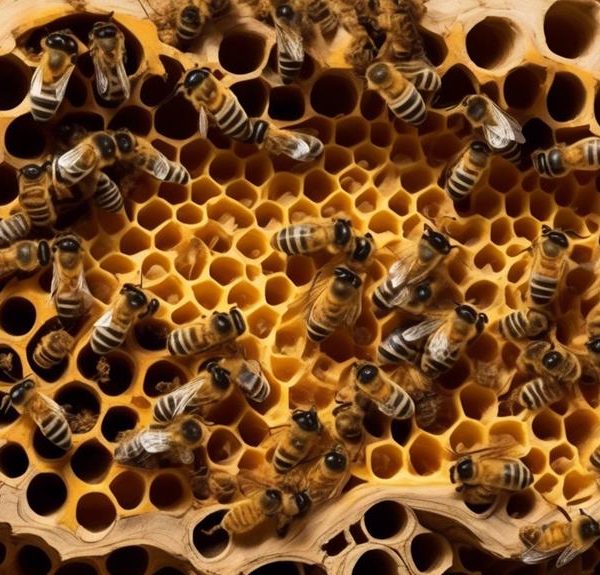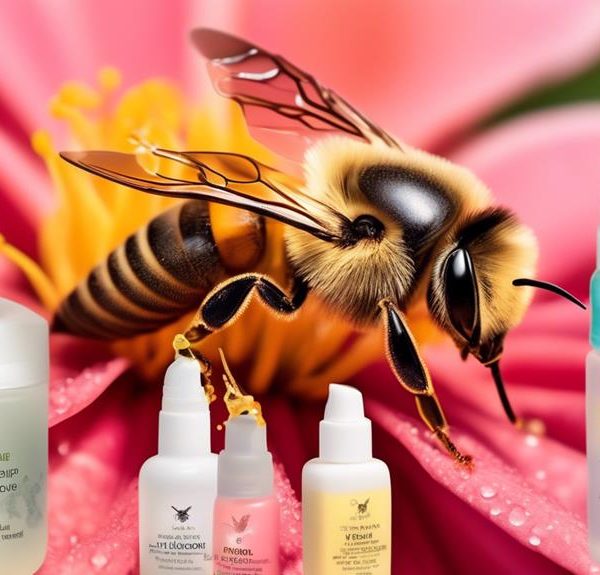Uncover the intricate journey of beeswax, from hive production to final purification, in this fascinating exploration of nature's most versatile product.
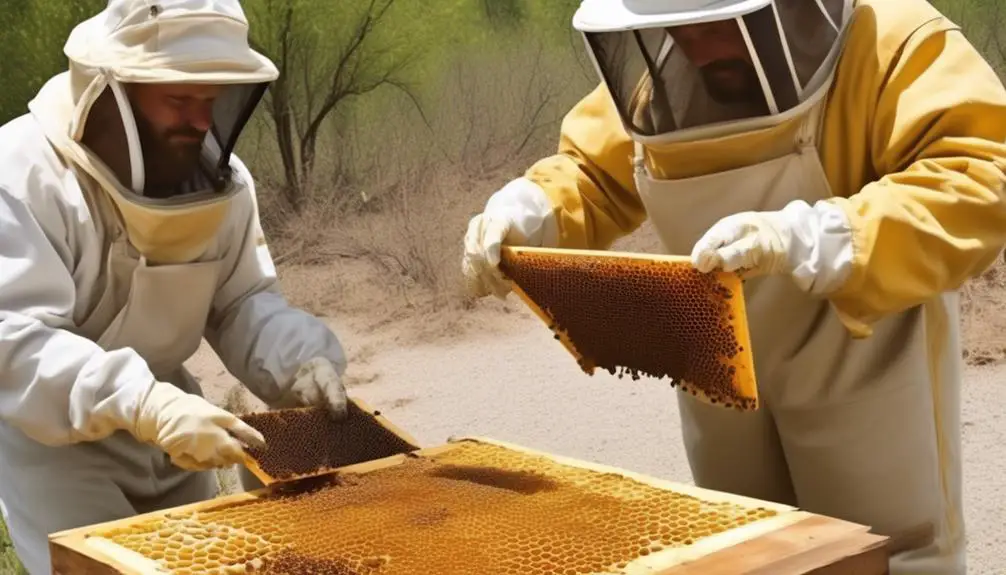
How Is Beeswax Processed?
Imagine being let in on the secret lives of bees, specifically their incredible ability to produce beeswax. You'd be surprised to know that it's not as simple as watching bees buzz around. There's a whole intricate process that you might not be aware of.
From the initial production of wax in the hive, to the meticulous harvesting, then onto the careful cleaning and melting, all the way to the final purifying and filtering stages, it's a journey that's as fascinating as it is complex.
And the end product? A versatile substance used in various industries. But let's not get ahead of ourselves – why don't we start from the beginning?
Key Takeaways
- Beeswax is produced by worker bees from special glands on their abdomen, and they need to be between 12 and 20 days old to produce wax.
- Beeswax is used by bees to build honeycomb cells in a perfect hexagon shape.
- Beekeepers harvest beeswax by carefully opening hives, removing frames, and using a heated knife to remove wax caps from honey cells.
- The process of processing beeswax involves initial cleaning and melting to remove impurities, purifying and filtering to achieve absolute purity, and then it can be molded into different forms for various uses.
The Natural Production of Beeswax
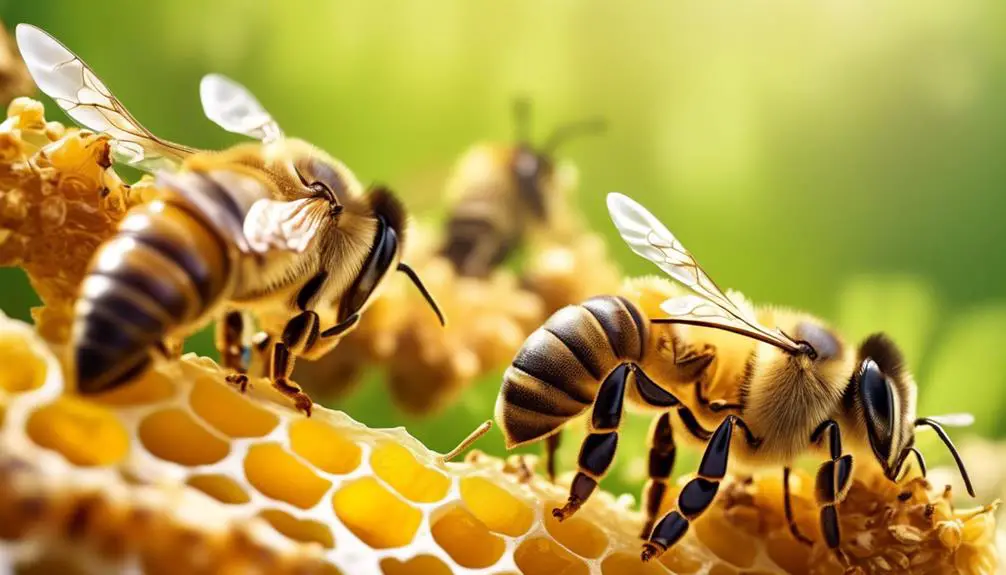
In order to truly appreciate the process of beeswax production, you need to understand how bees naturally create this versatile substance. It's not as straightforward as you might think.
Worker bees, who are all female, produce beeswax from special glands on their abdomen. But they can't do it straight away. They've to be between 12 and 20 days old before they're ready to produce wax.
When they're old enough, they start to secrete tiny wax flakes. These flakes are initially transparent and colorless but turn into the familiar yellowish hue of beeswax as they oxidize and get mixed with pollen. The bees then chew these wax flakes, mixing them with saliva to make them soft and moldable.
Once the bees have their beeswax ready, they use it to build their honeycomb structure, where they store honey and raise their young. It's an incredibly efficient process. Each honeycomb cell is a perfect hexagon, allowing bees to make the best use of space in the hive.
The beeswax process is a fascinating example of nature's ingenuity, and understanding it can enhance your appreciation of this valuable substance.
Harvesting Beeswax From Hives
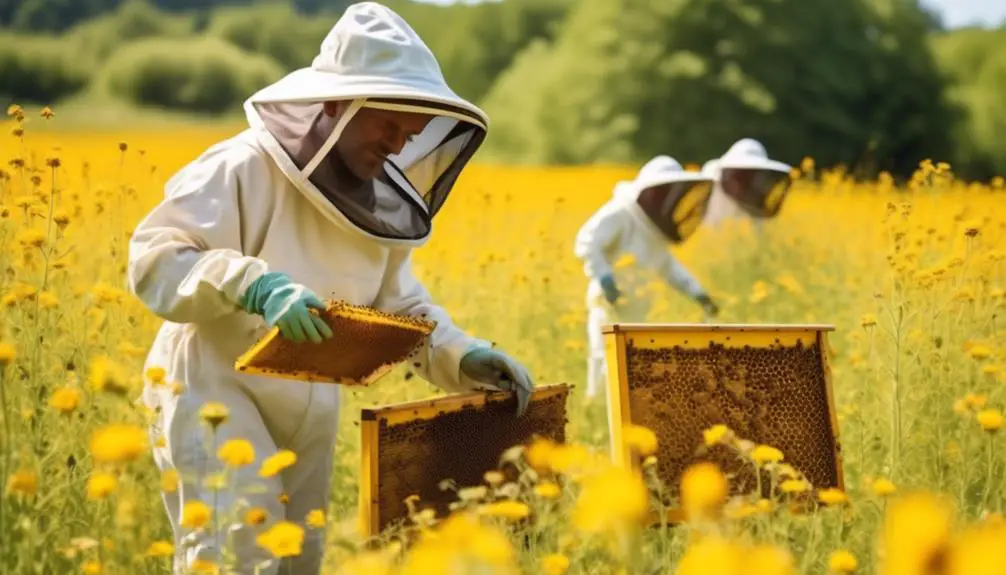
Now that you've gained insight into the natural production of beeswax, let's explore how this precious substance is harvested from the hives.
Beekeepers, clad in protective gear, approach hives with care to collect honeycombs. They use a specialized tool called a hive tool to pry open the hive and pull out the frames. It's on these frames where the magic happens – bees build their wax cells.
The frames are then brought to a controlled environment. Using a heated knife, beekeepers slice off the wax caps that seal the honey in the cells. This wax, rich in honey, is known as cappings wax and it's the highest quality beeswax you can get.
Once the caps are removed, the frames are placed in a centrifugal extractor that spins the honey out. The remaining beeswax on the frames is scraped off with the hive tool and collected. This wax is known as slumgum and is lower quality due to impurities.
The collected wax, both cappings and slumgum, is then melted down in a solar wax melter or a double boiler. The melted beeswax is strained to remove impurities and then cooled to form blocks.
Now, you have harvested, processed beeswax ready for use.
Initial Cleaning and Melting Process
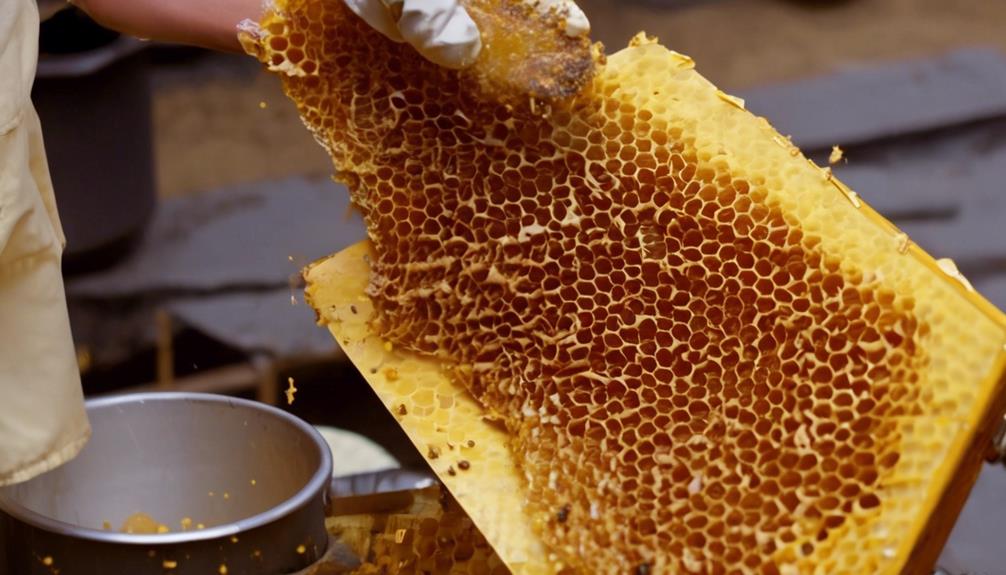
Diving into the initial cleaning and melting process, you'll find that refining your harvested beeswax begins with a simple yet crucial step: removing any remaining impurities. You'll need to filter out hive debris, dead bees, and other contaminants to get the wax ready for melting. Using a coarse strainer will help you catch the larger particles, while a fine mesh sieve will help you filter out the smaller ones.
Once the wax is cleaned, it's time to move onto the melting process. You'll want to use a double boiler to melt your beeswax, as it allows for a gradual and controlled increase in temperature. It's important to keep the heat low to prevent any risk of the wax catching fire or losing its beneficial properties. As the wax melts, you'll notice a change in its consistency and color – from a solid, yellowish block to a clear, golden liquid.
Remember to stir the wax gently and regularly to ensure even melting. Once fully liquefied, pour the wax through a cloth into a mold or container, separating the final impurities. You've now successfully undergone the initial cleaning and melting process of beeswax.
Purifying and Filtering Beeswax
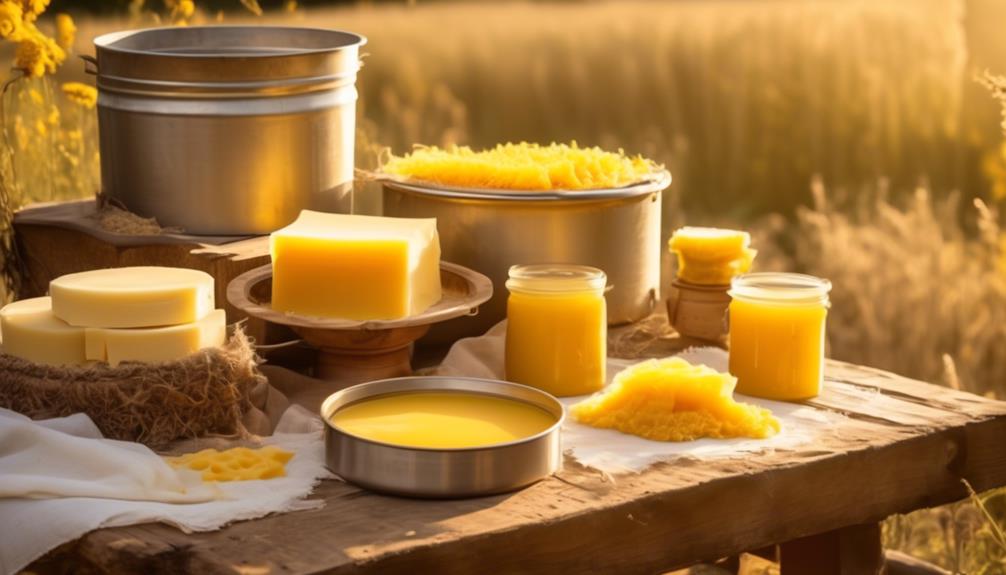
Once you've melted and initially cleaned your beeswax, it's time to delve into the crucial steps of purification and filtration. These processes are essential for removing any remaining impurities and ensuring a clear, clean product.
Begin by heating your melted beeswax to a temperature of around 150 degrees Fahrenheit. This will ensure the wax remains in a liquid state, allowing for effective purification. It's important to heat the wax slowly and stir it constantly to prevent burning.
Next, it's time to filter the beeswax. You can use a strainer lined with cheesecloth for this purpose. Pour the hot wax carefully into the strainer, and let it slowly drip into a clean container. The cheesecloth will capture any impurities or debris, leaving you with pure, filtered beeswax.
If you notice any remaining impurities after the initial filtration, don't hesitate to repeat the process. The goal here is absolute purity.
Final Forms and Uses of Beeswax
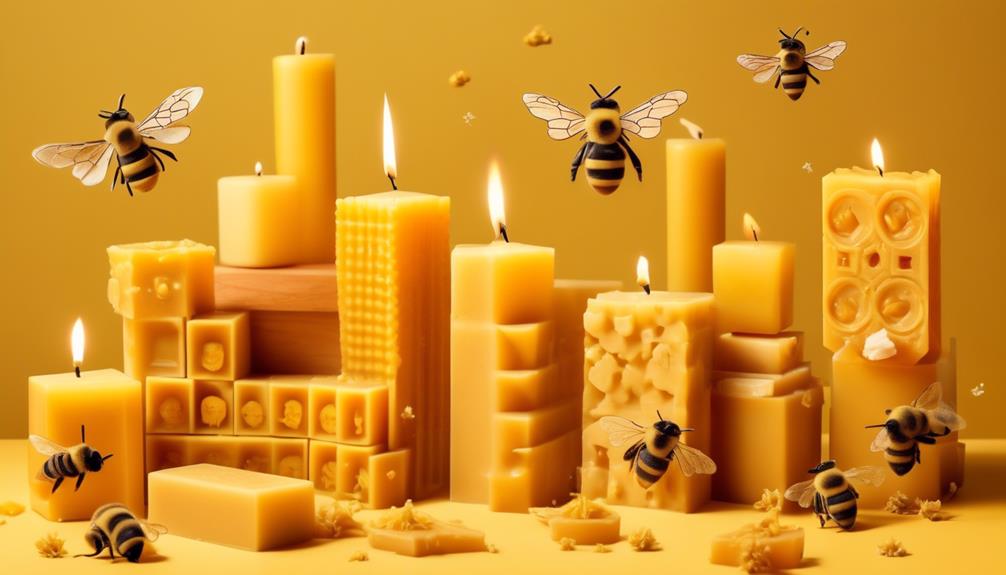
After you've painstakingly purified your beeswax, it's ready to be shaped into its final form and put to good use. You can mold the beeswax into blocks, pellets, or bars, depending on your specific needs. These forms are easier to store and use for various applications.
Now, let's dive into the many uses of beeswax. You're likely familiar with beeswax candles, which burn slower and cleaner than their paraffin counterparts. They're a perfect choice if you're seeking a natural, long-lasting light source. But beeswax's applications extend far beyond candles.
In the cosmetic industry, it's a key ingredient in lip balms, lotions, and soaps due to its moisturizing properties and natural origin. It also hardens these products without synthetic additives.
In the world of food, beeswax is used to coat cheese, preserving its freshness and preventing molds. Woodworkers also appreciate beeswax as a natural polish for furniture, maintaining its luster while protecting it from damage.
Lastly, it's used in encaustic painting, a technique dating back to ancient Egypt, where it's prized for its rich texture and durability. As you can see, your pure beeswax is versatile and valuable in numerous fields.
Frequently Asked Questions
What Are the Health Benefits of Using Beeswax?
Beeswax offers you several health benefits.
It's a natural moisturizer, great for dry skin and lips.
It's also anti-inflammatory, helping to soothe irritated skin.
Beeswax forms a protective barrier, locking in moisture and defending your skin against environmental damage.
It's packed with vitamin A, promoting cell regeneration and health.
Plus, it's antibacterial, keeping your skin clean and reducing acne.
Are There Any Risks or Harms Associated With the Beeswax Processing?
Yes, there are risks involved in beeswax processing. You're exposed to high temperatures during the melting process, posing a burn risk.
Inhalation of beeswax particles or fumes can cause respiratory issues.
Also, if not carefully sourced, beeswax can contain pesticides, harming both you and the environment.
Always ensure you're handling beeswax with appropriate safety measures and sourcing it from reputable, organic beekeepers.
How Can One Determine the Quality of Beeswax?
To determine the quality of beeswax, you'll need to check its color, aroma, and texture. High-quality beeswax is golden yellow with a sweet, honey-like smell. It's also smooth and free from impurities.
If it's gray or has a smoky smell, it's likely been processed poorly. Remember, quality can vary depending on the bee's diet and the flowers they've pollinated, so it's not always a clear-cut determination.
Is There Any Legal Regulation or Control Over Beeswax Processing?
Yes, there are regulations in place for beeswax processing. Depending on your location, different laws might apply. You'll need to check the specifics in your area.
These rules ensure beeswax's quality and safety. They cover everything from the treatment of the bees, harvesting procedures, to the actual processing of the wax.
It's essential to comply with these regulations, as they're designed to protect both the consumer and the environment.
What Are the Environmental Impacts of Beeswax Production and Processing?
You're asking about the environmental impact of beeswax production and processing. It's relatively low-impact, as bees produce wax naturally. However, beekeeping practices can affect the environment.
Overharvesting can stress bee colonies, and pesticides used in hives can harm local ecosystems. Additionally, energy used in processing and transporting beeswax can contribute to carbon emissions.
It's crucial to source beeswax from sustainable, ethical beekeepers to minimize environmental harm.
Conclusion
So, you've traversed the journey from hive to home, understanding how beeswax is produced, harvested, and processed.
It's a meticulous journey, from initial cleaning to purification, making every bit of beeswax a testament to nature's genius and human ingenuity.
Whether it's shaping candles, crafting cosmetics, or polishing furniture, beeswax proves versatile.
Next time you use a beeswax product, remember the hard work and precision that goes into its creation.

